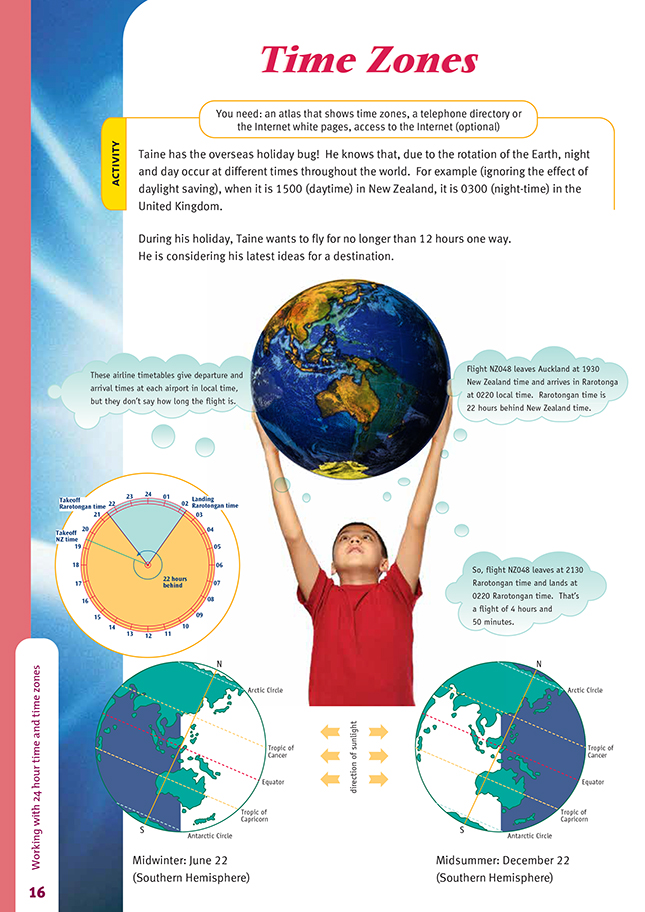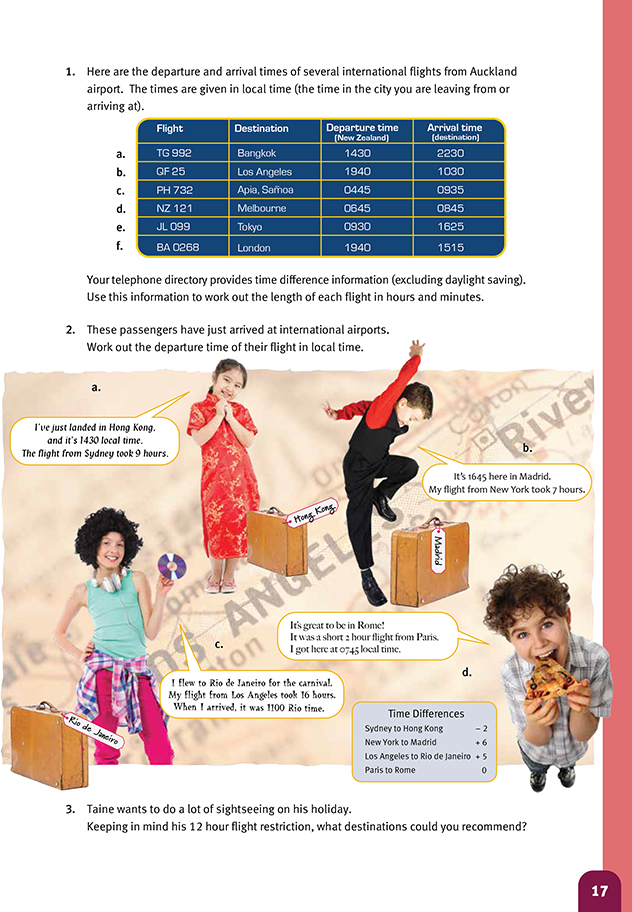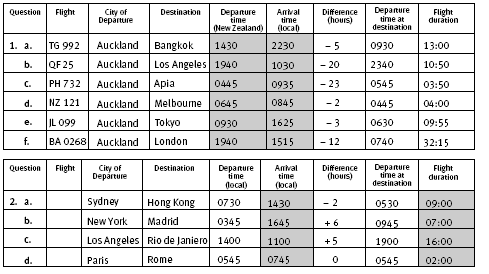This is a level 4 measurement activity from the Figure It Out theme series.
Click on the image to enlarge it. Click again to close. Download PDF (148 KB)
solve time problems involving time zones
- An atlas that shows time zones
- A telephone directory or the Internet White Pages
- FIO, Levels 4-4+, Theme: Getting Around, Time Zones, pages 16-17
- Access to the Internet (optional)
This task reinforces earlier work with 24 hour time but with the added complication of moving between different time zones. As the teacher, you should work through this activity before giving it to your students because it is very easy to make mistakes!
To see what information they have and what they don’t have, the students may like to put the given information into a table, or tables, like the ones below. Here, the given information is in the shaded cells; what needs to be found is in the white cells.
In each case, the time zone difference between departure point and arrival point needs to be determined. This information can be found at the front of the telephone directory, in the section headed International Country and Area Codes. It can also be found on a number of Internet sites, including ww.timetableanddate.com/worldclock.
If the telephone directory is used, daylight saving will need to be ignored (as in the instructions in the student book). If the Internet is being used, students will be able to take daylight saving into account.
In question 1, a suitable approach is:
• Determine what the time is in the destination country at the point when the plane is flying out from the departure country.
• Calculate the difference between this time and the arrival time to get the travel time (flight duration).
Using 1e as an example:
• The departure time in the destination country is 0930 – 3 hrs = 0630.
• From 0630 to 1625 is 05:30 + 04:25 = 09:55 (9 hours and 55 minutes).
Using 1f as a further example:
• The departure time in the destination country is 1940 – 12 hrs = 0740.
• From 0740 to 1515 is 04:20 + 03:15 = 07:35 (7 hours and 35 minutes). But this distance can’t be flown in such a short time, so there must be an additional 24 hours in there (including a stopover). The total time thus becomes 31:35 (31 hours and 35 minutes).
In question 2, the task is very similar, except that the students are given arrival time and flight duration, and from these they have to work out the departure time.
It would be useful to have pairs of students comparing their answers for these activities. Where they get different results, they can determine who has made the error and what the error is. Working is given in the answers for each part of these two questions so that, if necessary, the studetns can get help with the process.
Answers to Activity
As noted in the activity, daylight saving is excluded from these answers.
1. a. Flight TG 992: Thailand is 5 hrs behind New Zealand.
Departure time is 1430 – 5 hrs = 0930 Thai time, so flight time is 2230 – 0930 = 13:00 (13 hrs).
b. Flight QF 25: Los Angeles is 20 hrs behind New Zealand.
Departure time is 1940 – 20 hrs = 2340 USA time, so flight time is 1030 – 2340 = 10:50 (10 hrs 50 min).
c. Flight PH 732: Apia is 23 hrs behind New Zealand.
Departure time is 0445 – 23 hrs = 0545 Sāmoan time, so flight time is 0935 – 0545 = 03:50 (3 hrs 50 min).
d. Flight NZ 121: Melbourne is 2 hrs behind New Zealand.
Departure time is 0645 – 2 hrs = 0445 Australian time, so flight time is 0845 – 0445 = 04:00 (4 hrs).
e. Flight JL 099: Tokyo is 3 hrs behind New Zealand.
Departure time is 0930 – 3 hrs = 0630 Japanese time, so flight time is 1625 – 0630 = 09:55 (9 hrs 55 min).
f. Flight BA 0268: London is 12 hrs behind New Zealand.
Departure time is 1940 – 12 hrs = 0740 United Kingdom time. 1515 – 0740 = 07:35, so flight time is 07:34 + 24:00 = 31:35. Flights to the United Kingdom take much longer than 7 or 8 hrs, so it must be 31 hrs 35 min (including a stopover).
2. a. The flight from Sydney to Hong Kong left Sydney at 1430 – 9 hrs = 0530 Hong Kong time. (Hong Kong is 2 hrs behind Australia, so the flight left Sydney at
0530 + 2 hrs = 0730 Australian time.)
b. The flight from New York to Madrid left at 1645 – 7hrs = 0945 Madrid time. (Madrid is 6 hrs ahead of New York, so the flight left New York at 0945 – 6 hrs = 0345 New York time.)
c. The flight from Los Angeles to Rio de Janiero left Los Angeles at 1100 – 16 hrs = 0500 on the previous day, or 1900 Rio time. (Rio is 5 hrs ahead of Los Angeles,
so the plane left Los Angeles at 1900 – 5 hrs = 1400 Los Angeles time.)
d. The flight from Paris to Rome left Paris at 0745 – 2 hrs = 0545 Rome time. (Rome and Paris share the same time.)
3. Answers will vary.


